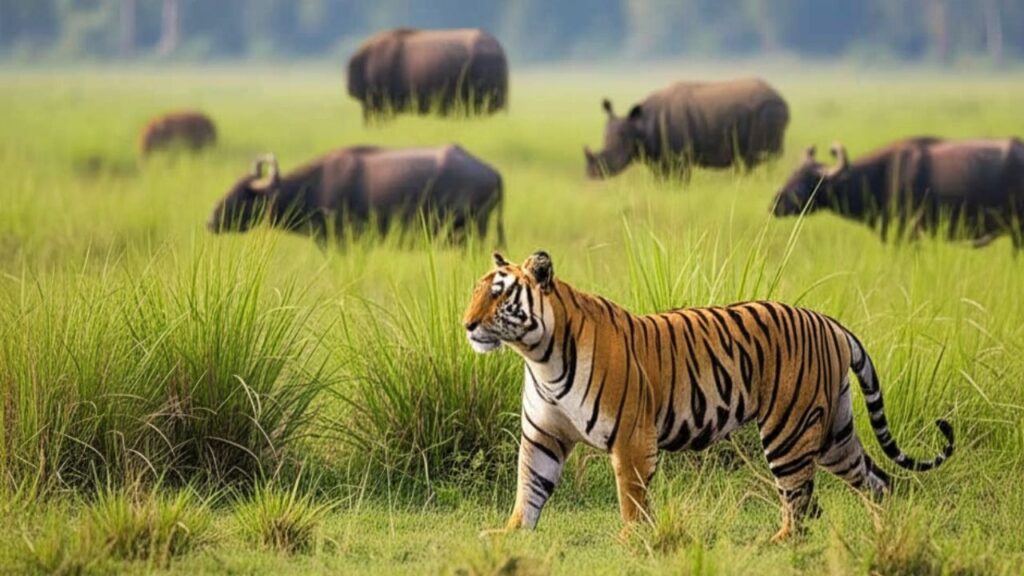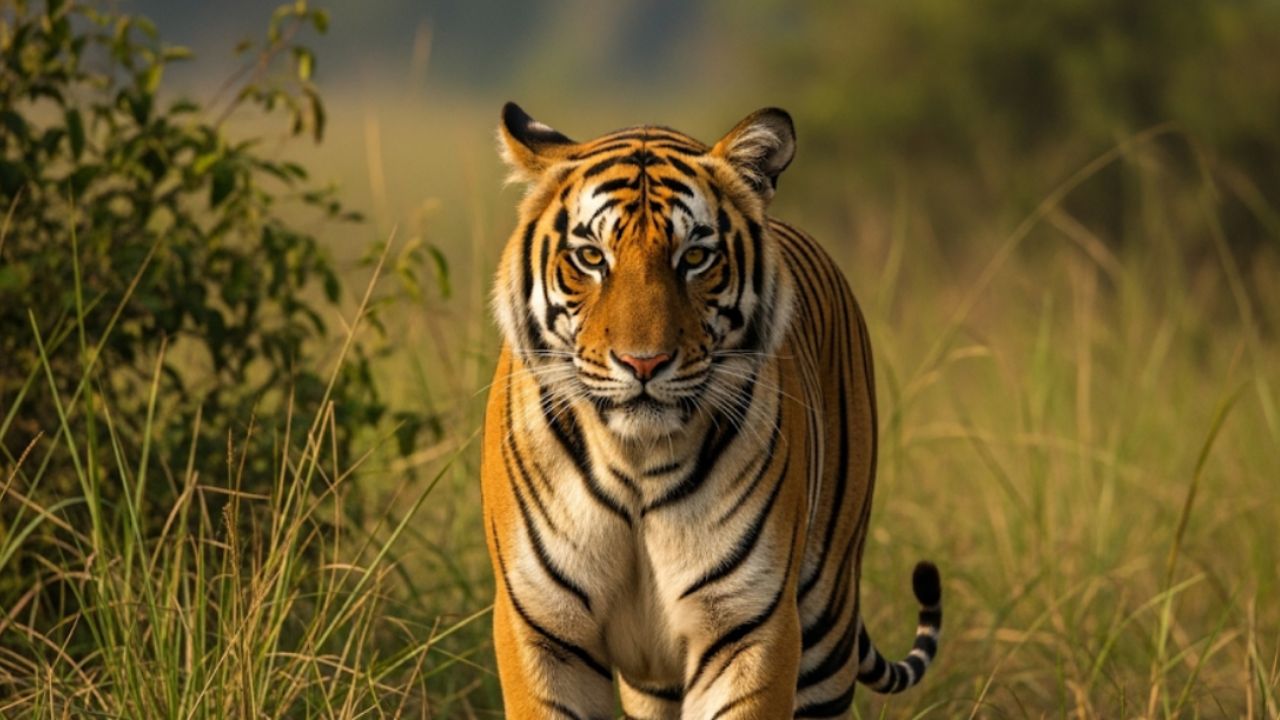Assam is roaring with pride as it marks International Tiger Day 2025, showcasing its remarkable success in tiger conservation. With the third-highest tiger density in the world, Assam is a global leader in protecting these majestic creatures. This year’s celebrations highlight the state’s efforts to reclaim tiger habitats and ensure their survival.
Assam’s Tiger Conservation Success
Assam has made incredible strides in tiger conservation, earning praise for its efforts to protect and expand habitats for the Royal Bengal Tiger. Chief Minister Himanta Biswa Sarma announced on International Tiger Day 2025 that Assam is not just safeguarding tigers but actively reclaiming their lost habitats through expanded reserves and anti-encroachment measures. This has led to a significant rise in the tiger population, with Assam now home to 227 tigers (up 19% from 190 in 2018), making it the state with the world’s third-highest tiger density.
Key Highlights of Assam’s Tiger Conservation
| Details | Information |
| Tiger Population (2022) | 227 (19% increase from 190 in 2018) |
| Top Reserve | Kaziranga National Park: 121 tigers (highest global density) |
| Other Key Reserves | Manas (48 tigers, tripled from 10), Orang, Nameri |
| Conservation Efforts | Anti-poaching, habitat restoration, community involvement |
| Challenges | Human-wildlife conflict, poaching, habitat encroachment |
| Source | SentinelAssam.com |
Assam’s Flagship Tiger Reserves
Assam’s tiger conservation success is driven by its iconic national parks and tiger reserves. Here’s a look at the key reserves:
- Kaziranga National Park: Home to 121 tigers, it boasts the highest tiger density globally. Known for its rare Golden Tiger and rich biodiversity, Kaziranga is a UNESCO World Heritage Site.
- Manas National Park: The tiger population has tripled from 10 to 48, a testament to effective conservation strategies.
- Orang National Park: Expanded to 279.14 sq km in 2022, Orang is a critical tiger habitat despite challenges like stray tigers and poaching.
- Nameri National Park: Supports tiger conservation through habitat restoration and anti-poaching efforts.
These reserves are central to Assam’s multi-pronged approach, which includes anti-poaching patrols, habitat restoration, and community involvement to balance human and wildlife needs. Environment and Forest Minister Chandra Mohan Patowary emphasized that these efforts have strengthened Assam’s position as a global conservation leader.

Challenges in Tiger Conservation
Despite the success, Assam faces challenges in sustaining its tiger population:
- Human-Wildlife Conflict: As tiger numbers grow, incidents of tigers straying into human settlements, like in Borsola, Sonitpur, create fear among locals.
- Poaching: Illegal wildlife trade remains a threat. In March 2025, two poachers were arrested in Baksa for attempting to sell tiger teeth.
- Habitat Encroachment: Expanding reserves requires clearing encroachments, which can lead to tensions with local communities.
- Tiger Deaths: In 2025, a decomposed Royal Bengal tiger was found in Biswanath Wildlife Division, and another died in Orang National Park, highlighting the need for better monitoring.
Assam is addressing these issues through stricter anti-poaching laws, community engagement, and advanced monitoring systems to ensure peaceful coexistence between humans and tigers.
Importance
International Tiger Day, celebrated annually on July 29, raises awareness about the need to protect tigers and their habitats. Assam’s 2025 celebrations highlight its commitment to this global cause, with initiatives like plantation drives, awareness campaigns, and stricter enforcement against poaching. The state’s efforts align with the global Tx2 initiative, launched in 2010, to double the wild tiger population.
FAQs About International Tiger Day and Project Tiger
Here are answers to common questions about International Tiger Day and Project Tiger:
| Question | Answer |
| When is International Tiger Day celebrated? | International Tiger Day is celebrated every year on July 29. It’s a global event to raise awareness about tiger conservation. |
| When and how did International Tiger Day start? | It began in 2010 at the Saint Petersburg Tiger Summit in Russia, where 13 tiger-range countries (including India) launched the Tx2 initiative to double the wild tiger population by 2022. July 29 was chosen to mark this commitment and promote global efforts to save tigers from extinction. |
| What is Project Tiger? | Launched in 1973 by the Government of India under Indira Gandhi’s leadership, Project Tiger is a conservation program to protect the Royal Bengal Tiger and its habitats. It established tiger reserves across India, including Assam’s Kaziranga, Manas, and Orang, and introduced measures like anti-poaching and habitat restoration. It’s a global benchmark for wildlife preservation. |
| What is the theme for International Tiger Day 2025? | The theme for 2025 is “Their Survival is in Our Hands”(though not officially announced), emphasizing collective responsibility to protect tigers from poaching, habitat loss, and climate change. It calls for stronger conservation efforts and community involvement. |
How You Can Support Tiger Conservation
- Spread Awareness: Share facts about tiger conservation on social media using hashtags like #InternationalTigerDay2025 and #SaveTigers.
- Support Reserves: Visit Assam’s national parks responsibly to promote eco-tourism.
- Report Illegal Activities: Inform authorities about poaching or illegal wildlife trade.
- Join Community Efforts: Participate in local conservation programs or plantation drives to restore tiger habitats.
Conclusion
Assam’s celebration of International Tiger Day 2025 showcases its remarkable progress in tiger conservation, with a 19% increase in tiger population and the third-highest tiger density globally. From Kaziranga’s record-breaking tiger numbers to Manas’ inspiring recovery, Assam is a shining example of how dedication, community involvement, and bold policies can protect endangered species. However, challenges like poaching and human-wildlife conflict require ongoing efforts.





